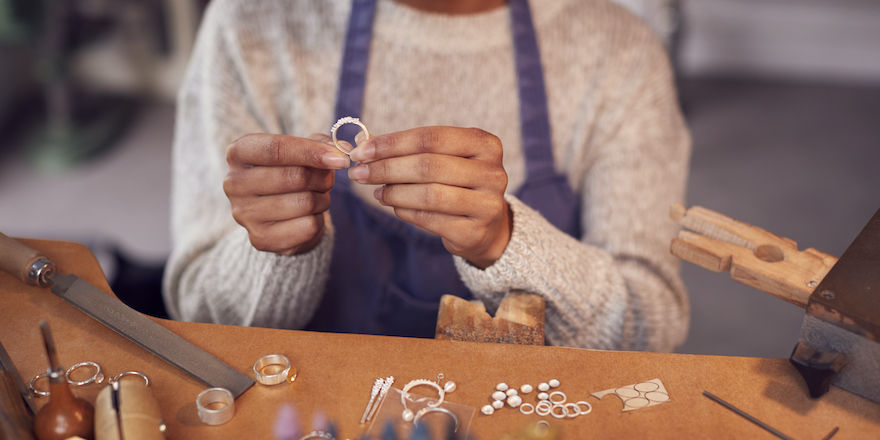
Table of Contents
Have you ever thought about pursuing a career as a jewellery designer? If you’re someone who is creative, fashion-forward, and good with your hands, this may be the career for you! As a jewellery designer, the possibilities for creativity, expression, and workplaces are endless!
Explore jewellery designing to discover if this is your dream career.
A jewellery designer designs, creates, repairs, cleans, and restores pieces of jewellery. They traditionally work with silver, gold, platinum, and gems to create jewellery like rings, earrings, bracelets, necklaces, and more. Jewellery designing requires artists to draw on their creativity to design unique pieces, background knowledge to bring the design to life, and in some cases, fundamental business skills to promote and market themselves.
How to become a jewellery designer in 3 simple steps:
If you can envision yourself as a jewellery designer, here’s what you’ll need to succeed:
A formal education in jewellery designing is not required to have a career in this field, but it will help you learn the proper skills to succeed, develop industry connections, and build your portfolio. An education will also open doors in your career for companies that may require some formal education or training. Not only will you learn about and identify quality materials, but you may also have access to essential work experience through a placement opportunity.
There are plenty of programs available where you can study the art and craft of jewellery designing. One of the top schools in jewellery design is George Brown College. Discover how Lina Avendano and Amanda Memme, two George Brown College alumni, have succeeded in their careers, from assisting with New York Fashion Week to appearing in art galleries and fashion magazines.
Step two: Develop your portfolio
A portfolio showcasing your jewellery designs will help prepare you for your career. When applying for jobs, you’ll have concrete examples of what you can do and what skills you have. Part of your program in jewellery designing will require you to create your own pieces of jewellery. Showcase your best pieces from your program, and other pieces you’ve made on your own in your portfolio. Here’s what makes a portfolio look professional:
- clear, brightly lit photographs of your jewellery, staged with a plain background to emphasize the design.
- show a variety of designs. Demonstrate your flexibility with working with different materials and designs.
- choose the pieces that make it into your portfolio wisely. You don’t want to overwhelm your audience by including everything you’ve ever created. Showcase your best work.
- have a physical and digital copy of your portfolio. The physical copy should be printed on high quality photo paper to show employers in-person, and the digital copy should be accessible online to email to employers.
Step three: Certifications
Some employers may require you to have additional certifications, or you may want to enhance your credentials. Certifications are a great way to improve your skills and set yourself apart from other jewellery designers. There is no one certification you need to have, but there are many that you can choose from based on your style of jewellery designing. The Canadian Jewellers Association (CJA) offers programs specialized in appraisals, diamond grading, precious metals, coloured gemstones and more. The Canadian Gemmological Association (CGA) offers courses that discuss gemmology, gem identification, and other individual gemmological topics. The Gemmological Association of Great Britain (Gem-A) is an internationally recognized qualification in gemmology and diamond studies.
You may think jewellery designing is straightforward, but this career involves many different professional duties such as:
- researching and assessing quality of materials
- creating jewellery pieces based on guidelines or designs
- using various equipment to cut, heat, form, and polish jewellery
- staying updated on fashion trends
- shaping, polishing, and smoothing jewellery
- redesigning jewellery by reducing sizes, mending clasps, making further adjustments
- collaborating with individuals to craft their desired design
Jewellery designing requires mastery of many different skills and techniques to thrive in this business. Here are some top skills and techniques you’ll need to acquire:
- attentive to detail
- steady hands
- innovative
- creative
- casting
- gemsetting
- metal finishing
- soldering
- sawing
- polishing
As with every other career, there are advantages and disadvantages you may experience.
Pros
Explore the positives of jewellery designing:
- can start your own business
- creative industry
- minimal paperwork/office administration involved
- an emotionally charged industry
- make connections with clients
- traditional work hours (don’t have to work on weekends unless you run your own business)
Cons
Discover the negatives to this career:
- limited promotion options
- not a high paying career
- non-transferable skills such as gemsetting
- demanding clients
- work can be inconsistent
With the skills you’ll learn from jewellery designing, you can work in any number of positions such as jeweller, jewellery repair, gemsetting, goldsmithing, silversmithing, and even your own business. This means that you could work anywhere in Canada. As for your salary, it’s difficult to determine what you may make after graduation due to the vast career opportunities, but according to Ontario Colleges, the average starting salary for graduates from a jewellery program can range from $25,000 to $30,000.
Does this career sound interesting to you? Explore your fashion-forward and creative side with a career in jewellery designing!
Find a program in jewellery designing
